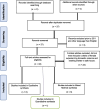Women escaping domestic violence to achieve safe housing: an integrative review
- PMID: 38822284
- PMCID: PMC11140925
- DOI: 10.1186/s12905-024-03143-7
Women escaping domestic violence to achieve safe housing: an integrative review
Abstract
Background: This integrative review summarises original research that explores women's experiences of escaping domestic violence to achieve safe housing.
Methods: Integrative review. A robust search strategy was conducted using the following databases: Scopus, Cumulative Index to Nursing and Allied Health (CINAHL), Cochrane, Medline and PubMed. All articles were assessed for quality using the Mixed Methods Appraisal Tools (MMAT) scoring. Whittemore and Knafl's (2005) five stage approach was used to analyse the primary literature related to women's and stakeholders' experiences of escaping domestic violence to achieve safe housing.
Results: A total of 41 articles were retrieved and 12 papers were included in this review (six qualitative, one quantitative and five mixed methods) that fulfilled the inclusion criteria. Four overarching themes were identified: 'Experiences of leaving domestic violence', 'Barriers to achieving safe housing', 'Facilitators to achieving safe housing' and 'The road to recovery'. The 'Experiences of leaving domestic violence' theme included two subthemes: 'the losses' and 'ongoing contact with the perpetrator'. The 'Barriers to achieving safe housing' theme included three subthemes: 'financial insecurity', 'being judged by others for leaving and service availability'. The 'Facilitators to achieving safe housing' theme included two sub-themes: 'support, partnership, and collaboration between women and service providers' and 'feeling respected and heard'. The 'Road to recovery' theme included two sub-themes: 'being a good mother' and 'empowerment after leaving domestic violence'.
Conclusions: This review has highlighted the need for service and health care providers to work together and collaborate effectively with the woman experiencing and escaping domestic violence, especially in rural and remote areas. This means giving women access to the most suitable educational resources and services that are appropriate for their unique situation. Tailoring support for women is crucial to enable women to achieve safe housing and to be able to live a safe life with their children, away from the perpetrator of the domestic violence.
Keywords: Domestic violence; Experiences; Integrative review; Intimate partner violence; Safe housing.
© 2024. The Author(s).
Conflict of interest statement
The authors declare no competing interests.
Figures
Similar articles
-
Midwives and women's experiences of Sterile Water Injections for back pain during labour: An integrative review.Midwifery. 2021 Dec;103:103164. doi: 10.1016/j.midw.2021.103164. Epub 2021 Oct 6. Midwifery. 2021. PMID: 34670166 Review.
-
Beyond the black stump: rapid reviews of health research issues affecting regional, rural and remote Australia.Med J Aust. 2020 Dec;213 Suppl 11:S3-S32.e1. doi: 10.5694/mja2.50881. Med J Aust. 2020. PMID: 33314144
-
The lived experiences of midwifery care for women with diabetes: An integrative review.Midwifery. 2020 Oct;89:102795. doi: 10.1016/j.midw.2020.102795. Epub 2020 Jul 13. Midwifery. 2020. PMID: 32711243 Review.
-
Women's Advocates and Shelter Residents: Describing Experiences of Working and Living in Domestic Violence Shelters.J Interpers Violence. 2020 Aug;35(15-16):3034-3053. doi: 10.1177/0886260517707307. Epub 2017 May 3. J Interpers Violence. 2020. PMID: 29294742
-
What is the role of health systems in responding to domestic violence? An evidence review.Aust Health Rev. 2017 Dec;41(6):639-645. doi: 10.1071/AH16155. Aust Health Rev. 2017. PMID: 28104041 Review.
Cited by
-
Navigating fragmented services: a gender-based violence (GBV) critical feminist analysis of women's experiences engaging with health and social supports in three Canadian cities.BMC Public Health. 2025 Mar 31;25(1):1213. doi: 10.1186/s12889-025-21919-w. BMC Public Health. 2025. PMID: 40165159 Free PMC article.
References
-
- Australian Institute of Health and Welfare (AIHW). Family, domestic and sexual violence. 2023. Available from https://www.aihw.gov.au/reports/domestic-violence/family-domestic-and-se....
-
- Australian Institute of Health and Welfare (AIHW). Family, domestic and sexual violence in Australia: continuing the national story 2019. Available from https://www.aihw.gov.au/reports/domestic-violence/family-domestic-sexual....
-
- Australia’s National Research Organisation for Women’s Safety. Domestic and family violence, housing insecurity and homelessness: research synthesis. (2nd Ed.; ANROWS Insights, 07/2019); 2019. Sydney: ANROWS. Available from https://www.anrows.org.au/publication/domestic-and-family-violence-housi....
-
- National Foundation for Australian Women Housing. Social Policy Position Papers. 2019. Retrieved from: https://www.nfaw.org/page/social-policy-position-papers (response to 2019–20 budget).
Publication types
MeSH terms
LinkOut - more resources
Full Text Sources


